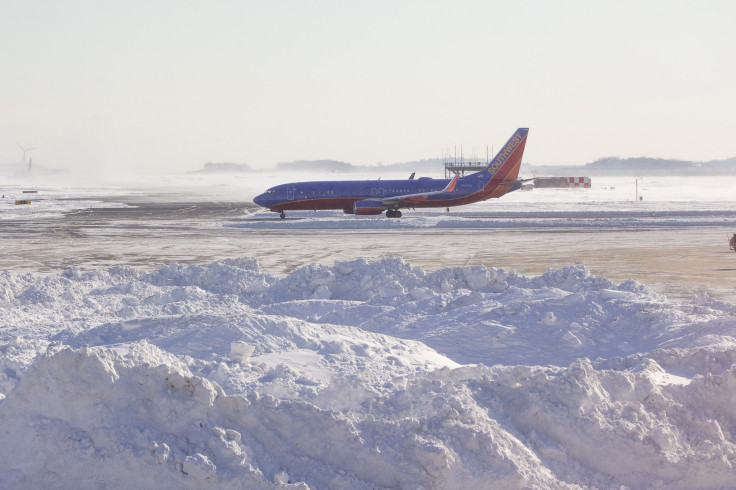Bomb Cyclone Effect In Utah: Salt Lake City Airport Flights Diverted

The National Weather Service on Sunday issued a dense fog advisory in Utah and cautioned visibility could be less than one-fourth mile.
According to the warning issued on the official site, the advisory would stay in effect till Monday. The advisory also stated the areas affected are Northern Wasatch Front, Salt Lake and Tooele Valleys.
The fog also affected the functioning of Salt Lake City International Airport on Sunday, the Salt Lake Tribune reported.
According to the report, 23 inbound flights were diverted to Provo and St. George and also to other airports located in the surrounding states. Twenty three outbound and 21 inbound flights, scheduled for Sunday evening and Monday morning, were also cancelled.
The report stated the flight delays were averaging in more than one and half hours Sunday evening. Salt Lake City airport, in a tweet, advised passengers to check with the officials for details regarding their particular airlines.
After the “bomb cyclone” caused thousands of delays last week, flights were resumed at John F. Kennedy Airport in New York, RTE News reported.
However, due to massive overcrowding many had to wait hours before deplaning. According to a tweet by Flighttrader24, passengers on Air China flight #CA989 had to wait seven hours before they could deplane Saturday. The tweet mentioned passengers in four other flights also waited for at least an hour to get off their respective aircrafts.
After 7 hours of waiting at JFK passengers from flight #CA989 have finally been able to leave the aircraft.
— Flightradar24 (@flightradar24) January 6, 2018
But there are more new flights that landed at JFK this morning, parked with passengers waiting to deplane.#AV20 - 2h 40min#AM400 - 2h#AV42 - 1h 50min#AI101 - 1h https://t.co/v0a9RKkrMG
One of the passengers on the flight took to Twitter to express her frustration.
Free at last! After a 14-hour flight from Beijing, and another 7-hours stranded on the @JFKairport TarMac, passengers aboard @airchina Flight #CA989 are deplaning. The next concern is lengthy customs lines. Our flight was just one of many that landed, but without a gate assigned pic.twitter.com/hzO1iUSPx0
— Jenni Monet (@jennimonet) January 6, 2018
According to another tweet by Flighttrader24, Norwegian flight #DY7015 from Gatwick, London, had to wait more than four hours to get its gate number.
Local time at JFK airport is 3:20 am and the gate situation is still very bad. Norwegian flight #DY7015 from Gatwick landed 11pm (4h 20min ago) and is still waiting for a gate. pic.twitter.com/kbl6SnnRJY
— Flightradar24 (@flightradar24) January 6, 2018
Amidst overcrowding at JFK Airport, a China Southern 777 aircraft’s wingtip hit the tail end of a Kuwait Airways 777 plane Saturday, which led to damages to both the planes.
##BREAKING Two planes clipped wing & tail. Sunwing tail caught fire. A Westjet aircraft evacuated via slides. No injuries reported. Toronto Pearson Fire on scene. pic.twitter.com/iOTQlfwRwq
— Tom Podolec Aviation (@TomPodolec) January 5, 2018
The incident took place outside Terminal 4 of the airport. There were no reports of any causalities, the New York Post reported.
Some passengers at JFK had to wait as much as 20 hours to get on their flight, according to a report by CBS.
The report stated the Port Authority of New York and New Jersey, which operated the airport, said it was working with the Federal Aviation Administration (FAA) to lessen the number of flights coming to the New York airport Saturday “until there are adequate gates available to handle the backlog of flights due to recovery of flight schedules in the wake of Thursday's storm."
Extreme cold temperatures were reported throughout the weekend. The northeast area of Burlington, Vermont, had temperatures plunging to minus one and winds at minus 30. New York and Philadelphia also saw low temperatures, which came down to eight degrees.
According to the mayor of Boston, Marty Walsh, the city saw a temperature of 11 degrees and faced a different kind of difficulty. He said pipes were getting frozen and cracked due to the cold, but there was a shortage of plumbers to get them fixed.
© Copyright IBTimes 2024. All rights reserved.





















